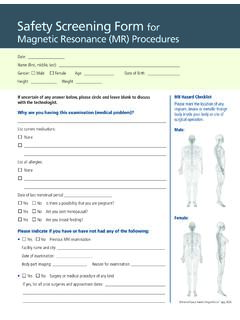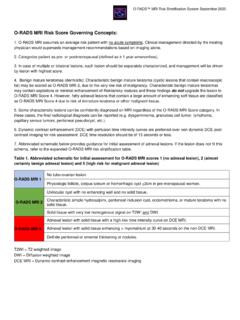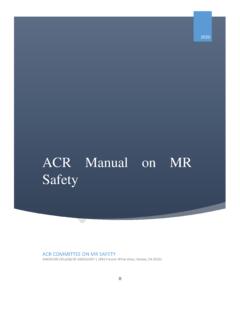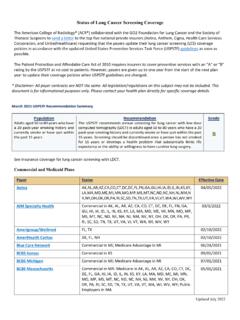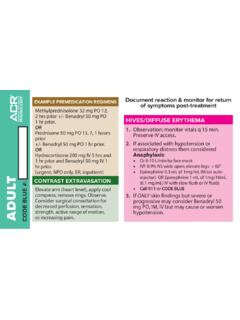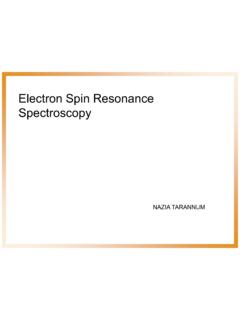Transcription of PI-RADS - ACR
1 PI-RADS ACR ESUR AdMeTech 2019 i PI-RADS Prostate Imaging Reporting and Data System 2019 Version PI-RADS ACR ESUR AdMeTech 2019 ii PI-RADS Prostate Imaging Reporting and Data System 2019 Version PI-RADS ACR ESUR AdMeTech 2019 iii ACKNOWLEDGEMENTS Administration Mythreyi Chatfield American College of Radiology, Reston Lauren Hicks American College of Radiology, Reston Dipleen Kaur American College of Radiology, Reston Cassandra Vivian-Davis American College of Radiology, Reston Steering Committee Jeffrey C.
2 Weinreb: Co-Chair Yale School of Medicine, New Haven Jelle O. Barentsz: Co-Chair Radboudumc, Nijmegen Peter L. Choyke National Institutes of Health, Bethesda Fran ois Cornud Ren Descartes University, Paris Masoom A. Haider University of Toronto, Sunnybrook Health Sciences Ctr Katarzyna J. Macura Johns Hopkins University, Baltimore Daniel Margolis University of California, Los Angeles Mitchell D. Schnall University of Pennsylvania, Philadelphia Faina Shtern AdMeTech Foundation Clare M. Tempany Harvard University, Boston Harriet C.
3 Thoeny University Hospital of Bern Baris Turkbey National Institutes of Health, Bethesda Andrew Rosenkrantz NYU Langone Health Geert Villeirs Ghent University Hospital Sadhna Verma University of Cincinnati PI-RADS ACR ESUR AdMeTech 2019 iv DCE Peter L. Choyke: Chair-DCE National Institutes of Health, Bethesda Aytekin Oto University of Chicago Masoom A. Haider University of Toronto, Sunnybrook Health Sciences Center Francois Cornud Rene Descartes University, Paris Fiona Fennessy Harvard University, Boston Sadhna Verma University of Cincinnati Pete Choyke National Institutes of Health, Bethesda Jurgen F tterer Radboudumc, Nijmegen DWI Francois Cornud: Chair Ren Descartes University, Paris Anwar Padhani Mount Vernon Cancer Centre, Middlesex Daniel Margolis University of California, Los Angeles Aytekin Oto University of Chicago Harriet C.
4 Thoeny University Hospital of Bern Sadhna Verma University of Cincinnati Peter Choyke National Institutes of Health, Bethesda Jelle Barentsz Radboudumc, Nijmegen Masoom A. Haider University of Toronto, Sunnybrook Health Sciences Ctr Clare M. Tempany Harvard University, Boston Geert Villeirs Ghent University Hospital Baris Turkbey National Institutes of Health, Bethesda Sector Diagram David A. Rini J Johns Hopkins University PI-RADS ACR ESUR AdMeTech 2019 v Other Reviewers/Contributors ESUR Alex Kirkham University College London Hospitals Clare Allen University College London Hospitals Nicolas Grenier University Boordeaux Valeria Panebianco Sapienza University of Rome Mark Emberton University College London Hospitals Jonathan Richenberg The Montefiore Hospital, Brighton Tristan Barrett University of Cambridge School of Clinical Medicine.
5 UK Vibeke L gager University of Copenhagen, Denmark Bernd Hamm Charit , Universit tsmedizin, Berlin, Germany Philippe Puech Lille University School of Medicine USA Martin Cohen Rolling Oaks Radiology, California John Feller Desert Medical Imaging, Indian Wells, Ca Daniel Cornfeld Yale School of Medicine, New Haven Art Rastinehad Mount Sinai School of Medicine John Leyendecker University of Texas Southwestern Medical Center, Dallas Ivan Pedrosa University of Texas Southwestern Medical Center, Dallas Andrei Purysko Cleveland Clinic Peter Humphey Yale School of Medicine, New Haven Preston Sprenkle Yale School of Medicine, New Haven Rajan Gupta Duke University Steven Raman UCLA Aytekin Oto University of Chicago PI-RADS ACR ESUR AdMeTech 2019 vi Daniel Costa University of Texas Southwestern Medical Center Samir Taneja NYU Langone Health Peter Pinto National Cancer Institute, Bethesda Leonard Marks UCLA China Liang Wang Tongji Medical College Australia Les Thompson Wesley Hospital.
6 Brisbane PI-RADS ACR ESUR AdMeTech 2019 vii TABLE OF CONTENTS INTRODUCTION .. 1 SECTION I: CLINICAL CONSIDERATIONS AND TECHNICAL SPECIFICATIONS .. 4 SECTION II: NORMAL ANATOMY AND BENIGN FINDINGS .. 7 SECTION III: ASSESSMENT AND REPORTING .. 10 SECTION IV: MULTIPARAMETRIC MRI (MPMRI) ..17 SECTION V: 25 APPENDIX 26 APPENDIX II .. 30 APPENDIX III .. 32 APPENDIX IV .. 41 APPENDIX V .. 42 43 FIGURES .. 53 PI-RADS ACR ESUR AdMeTech 2019 1 INTRODUCTION Magnetic Resonance Imaging (MRI) has been used for noninvasive assessment of the prostate gland and surrounding structures since the 1980s.
7 Initially, prostate MRI was based solely on morphologic assessment using T1-weighted (T1W) and T2-weighted (T2W) pulse sequences, and its role was primarily for locoregional staging in patients with biopsy proven cancer. However, it provided limited capability to distinguish benign pathological tissue and clinically insignificant prostate cancer from significant cancer. Advances in technology (both in software and hardware) have led to the development of multiparametric MRI (mpMRI), which combines anatomic T2W imaging with functional and physiologic assessment, including diffusion-weighted imaging (DWI) and its derivative apparent-diffusion coefficient (ADC) maps, dynamic contrast-enhanced (DCE) MRI, and sometimes other techniques such as in-vivo MR proton spectroscopy .
8 These technologic advances, combined with a growing interpreter experience with mpMRI, have substantially improved diagnostic capabilities for addressing the central challenges in prostate cancer care: 1) Improving detection of clinically significant cancer, which is critical for reducing mortality; and 2) Increasing confidence in benign diseases and dormant malignancies, which are not likely to cause morbidity in a man s lifetime, in order to reduce unnecessary biopsies and treatment. Consequently, clinical applications of prostate MRI have expanded to include not only locoregional staging, but also tumor detection, localization (registration against an anatomical reference), characterization, risk stratification, surveillance, assessment of suspected recurrence, and image guidance for biopsy, surgery, focal therapy and radiation therapy.
9 In 2007, recognizing an important evolving role for MRI in assessment of prostate cancer, the AdMeTech Foundation organized the International Prostate MRI Working Group, which brought together key leaders of academic research and industry. Based on deliberations by this group, a research strategy was developed and a number of critical impediments to the widespread acceptance and use of MRI were identified. Amongst these was excessive variation in the performance, interpretation, and reporting of prostate MRI exams.
10 A greater level of standardization and consistency was recommended in order to facilitate multi-center clinical evaluation and implementation. In response, the European Society of Urogenital Radiology (ESUR) drafted guidelines, including a scoring system, for prostate MRI known as Prostate Imaging-Reporting and Data System version 1 ( PI-RADS v1). Since it was published in 2012, PI-RADS v1 has been validated in certain clinical and research scenarios. However, experience has also revealed several limitations, in part due to rapid progress in the field.



